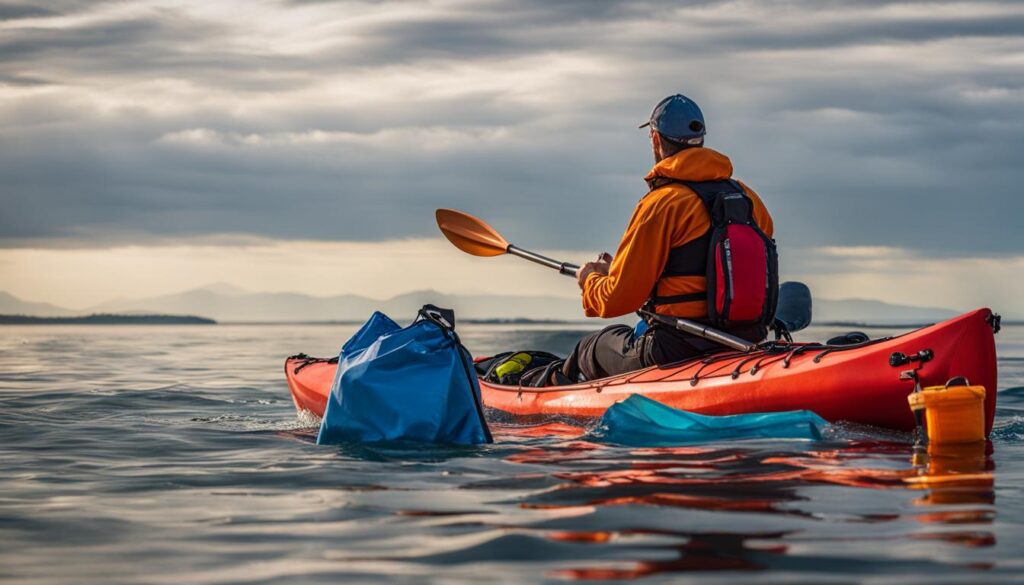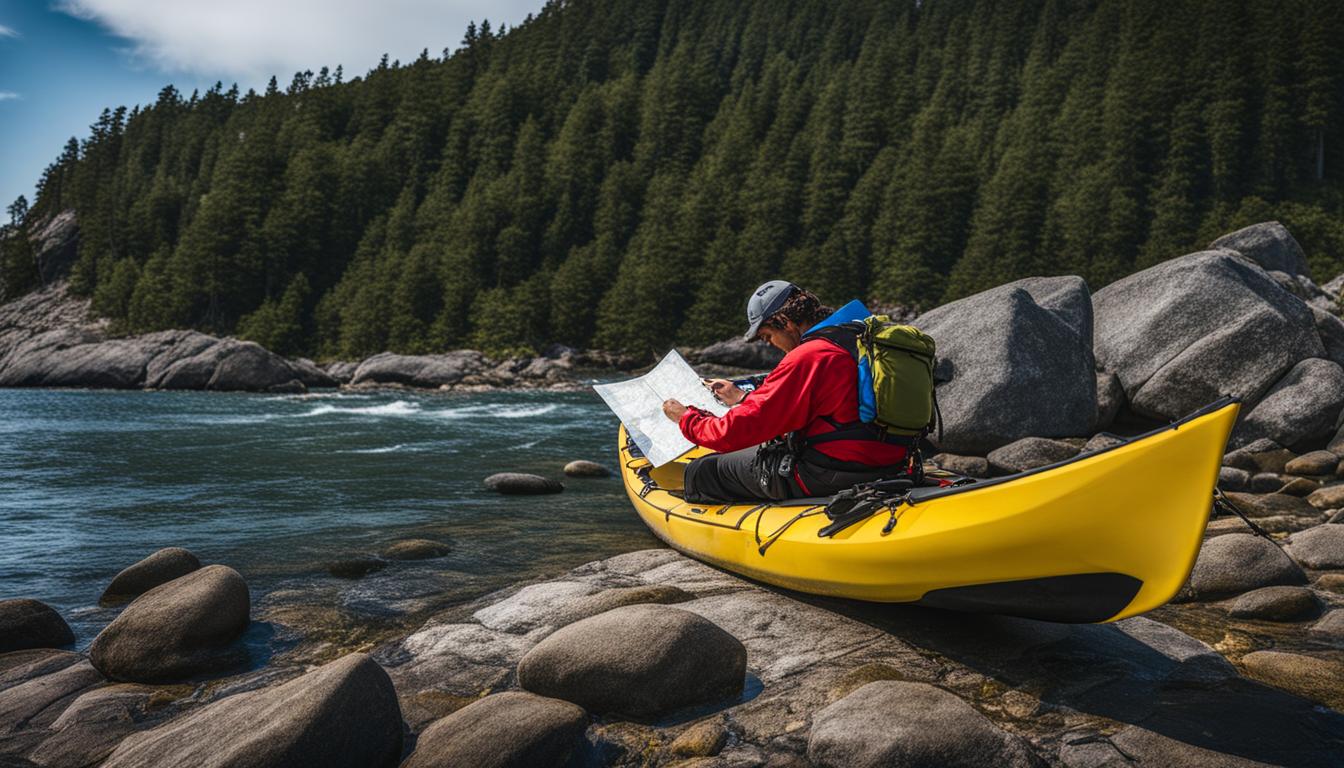Are you planning a sea kayaking adventure? To ensure a successful trip, effective route planning is crucial. By utilizing kayaking route planning, sea kayak trip mapping, and kayak trip navigation planning strategies, you can navigate the water with confidence and reach your destination safely.
Key Takeaways:
- Understanding water dynamics, such as wind and current patterns, is essential for choosing the most efficient course.
- Charts and visual landmarks can help you navigate the water and stay on track.
- Knowing your paddling speed will allow you to estimate distance and time accurately.
- Proper equipment, including a sea kayak, paddle, and personal flotation device (PFD), is essential for safety.
- Before setting off, map your trip, check the weather, and follow safety precautions to ensure a smooth and enjoyable experience.
Using Charts and Landmarks for Navigation
When planning a sea kayaking journey, understanding how to effectively navigate the water is crucial for a successful and safe adventure. One of the key tools for navigation is the use of charts and landmarks. These resources allow you to identify important features on the water and create a route that will lead you to your destination.
Charts and nautical maps provide valuable information about the area you’ll be kayaking in. They show details such as depth contours, channels, and potential hazards, enabling you to plan your route accordingly. By studying these charts, you can identify significant landmarks, such as sea stacks or major headlands, which can serve as reference points during your journey.
When out on the water, navigating by line of sight using these landmarks can be very effective. By linking up a series of landmarks along your route and referencing them on your chart, you can easily track your progress and make sure you stay on course. This technique is especially useful when making crossings in open water or navigating through foggy conditions.
| Chart Features | Benefits |
|---|---|
| Depth contours | Helps identify shallow and deep areas |
| Channels | Indicates safe passages through potentially hazardous areas |
| Hazards | Highlights potential dangers to avoid |
Another navigation technique that can be useful is the use of ranges. Ranges involve aligning two stationary objects on land to define a straight line. By maintaining this line of sight, you can ensure that you’re moving in the right direction. Ranges are especially helpful when navigating narrow channels or passages with specific entry points.
“Using charts and landmarks for navigation is a skill that every sea kayaker should master. It allows you to plan your route, track your progress, and make informed decisions on the water.”
By utilizing charts, identifying landmarks, and employing range techniques, you can navigate your sea kayaking journey with confidence. These strategies will not only help you stay on course but also provide a sense of direction and ensure a memorable adventure.
Essential Equipment for Sea Kayaking
When preparing for a sea kayaking trip, it’s important to have the right equipment to ensure a safe and enjoyable experience. Here is a list of essential items you should pack:
- A sea kayak: Choose a kayak suitable for your skill level and the type of water you’ll be paddling in.
- A paddle: Select a paddle that is the correct length and style for your body size and kayaking technique.
- A personal flotation device (PFD): Always wear a properly-fitted PFD to keep you buoyant and safe in the water.
- A spray skirt: This helps keep water out of your kayak, especially in rough conditions or when rolling.
- A manual water pump: Useful for removing any water that enters your kayak.
- Waterproof bags (dry bags): Keep your belongings dry by packing them in waterproof bags.
- Tow systems: If you’re going on a longer trip or navigating challenging waters, a tow system can come in handy for assisting others or being assisted yourself.
Additionally, if you plan to go fishing during your sea kayaking adventure, you’ll need some specific gear and knowledge. Here are a few tips:
“When fishing from a kayak, it’s important to have the right equipment. Some essential fishing gear includes a fishing rod and reel, tackle box, and appropriate bait or lures. Make sure to secure your fishing equipment to your kayak to prevent loss in case of capsizing. Familiarize yourself with local fishing regulations and practice catch-and-release to preserve the ecosystem. Always prioritize safety and consider taking a fishing safety course before embarking on your sea kayaking fishing trip.”
Remember, packing the right clothing, food, water, first aid kit, repair kit, navigation tools, and power banks/solar panels is also important for a successful journey. By having the right equipment, you’ll be well-prepared for your sea kayaking adventure and can fully enjoy the beauty of the water.

| Essential Equipment | Additional Fishing Gear |
|---|---|
| Sea kayak | Fishing rod and reel |
| Paddle | Tackle box |
| Personal flotation device (PFD) | Bait or lures |
| Spray skirt | Fishing line |
| Manual water pump | Fishing hooks |
| Waterproof bags (dry bags) | Fishing accessories |
| Tow systems | N/A |
Preparing for Your Sea Kayaking Adventure
Before embarking on your sea kayaking adventure, there are a few important steps you need to take to ensure a safe and enjoyable experience. By mapping your trip, checking the weather, and making necessary preparations, you can make the most of your kayak journey.
Map Your Trip
Mapping your trip is an essential step in preparing for your sea kayaking adventure. Take the time to research and plan your route, identifying any points of interest or potential hazards along the way. By having a clear understanding of your route, you can make informed decisions while on the water. You may also want to mark key landmarks or points on your map to help with navigation during your journey.
Check the Weather
Checking the weather conditions before setting out on your sea kayaking trip is crucial for your safety and overall experience. Pay attention to wind forecasts, tide patterns, and current information. This will help you determine the best time to embark on your journey and choose the most suitable route. Keep in mind that weather conditions can change quickly, so make sure to stay updated throughout your trip.
Kayak Trip Preparation
Proper preparation is key to a successful sea kayaking adventure. Here are a few important steps to consider:
- Ensure you have the necessary equipment, including a sea kayak, paddle, personal flotation device (PFD), spray skirt, and waterproof bags (dry bags).
- Pack essential items such as food, water, extra clothing, a first aid kit, repair kit, navigation tools, and power banks/solar panels.
- Familiarize yourself with the area where you will be kayaking and be aware of any specific regulations or guidelines.
- Double-check that your kayak is in good condition and make any necessary repairs or adjustments.
- Inform a trusted friend or family member about your trip, including your planned route and estimated return time.
By following these steps, you can ensure that you’re well-prepared for your sea kayaking adventure and have a safe and enjoyable experience on the water.

Safety Precautions for Sea Kayaking
When engaging in sea kayaking, it is crucial to prioritize your safety. By following proper sea kayak paddling techniques, practicing self-rescue, and being aware of potential risks, you can ensure a safe and enjoyable journey on the water.
Master Proper Sea Kayak Paddling Technique
Understanding how to paddle effectively is essential for maintaining stability and maneuverability in various conditions. Use your body to control the kayak, engaging your core muscles to generate power and maintain balance. Adjust your paddle strokes to suit the wind, waves, and currents, allowing you to navigate smoothly through the water. By mastering these techniques, you can enhance your overall paddling experience.
Practice Self-Rescue Techniques
Accidents happen, and it is important to be prepared for them. Familiarize yourself with self-rescue techniques to ensure your ability to handle various emergency situations, such as capsizing or being in rough water. Learn how to re-enter your kayak from the water, and practice these skills in a controlled environment before venturing out on your sea kayaking adventure.
Be Aware of Potential Risks and Hazards
Before setting out, research and familiarize yourself with the area you will be kayaking in. Understand the local conditions, such as tides, currents, and weather patterns. Be aware of potential hazards, such as strong offshore winds or rocky coastlines, and plan your route accordingly. By staying informed and alert, you can avoid unnecessary risks and ensure a safe journey.
Remember, safety should always be your top priority when sea kayaking. Taking the time to develop your skills, practicing self-rescue techniques, and being aware of potential risks will help you have a smooth and enjoyable experience on the water.
Conclusion
Congratulations on reaching the end of our sea kayaking adventure guide! We hope you’ve found this information helpful in planning your own exciting kayak trip.
By utilizing charts, landmarks, and ranges for navigation, you can confidently navigate the waters and explore new areas. Remember to pack the essential equipment and gear necessary for a safe and enjoyable journey. Safety should always be a top priority, so make sure to familiarize yourself with proper paddling techniques and self-rescue methods.
As you embark on your sea kayaking adventure, take the time to immerse yourself in nature and disconnect from the demands of everyday life. Plan your trip carefully, stay updated with weather conditions, and make lasting memories on the water.
So grab your paddle, hop in your kayak, and set off on an incredible journey. Enjoy the beauty of the sea, embrace the challenges, and experience the joy of sea kayaking. Have a fantastic adventure, and may your kayak trip be filled with unforgettable moments!
FAQ
What are some effective strategies for route planning in sea kayaking?
Effective route planning in sea kayaking involves using charts and visual landmarks, understanding water dynamics such as wind and current patterns, and knowing your paddling speed to estimate distance and time.
How can I navigate using charts and landmarks while sea kayaking?
Charts and nautical maps are valuable tools for planning and navigating sea kayak routes. By identifying landmarks and features on the water and using line-of-sight navigation techniques, you can stay on course and track your progress.
What essential equipment do I need for a sea kayaking trip?
Essential equipment for sea kayaking includes a sea kayak, paddle, personal flotation device (PFD), spray skirt, manual water pump, waterproof bags (dry bags), tow systems, and appropriate fishing gear if you plan to fish during your trip.
How should I prepare for my sea kayaking adventure?
Before embarking on your sea kayaking adventure, you should map your trip, check the weather conditions, and follow the recommendations and instructions provided by your adventure travel company. This ensures a smooth and stress-free experience.
What safety precautions should I take while sea kayaking?
Safety is a top priority in sea kayaking. It’s important to master proper paddling techniques, practice self-rescue techniques, and be aware of potential risks and hazards on the water. By following these precautions, you can minimize risks and have a safe and enjoyable journey.





